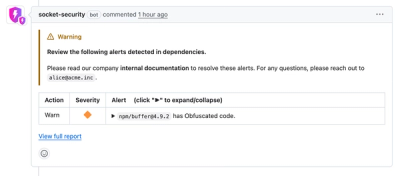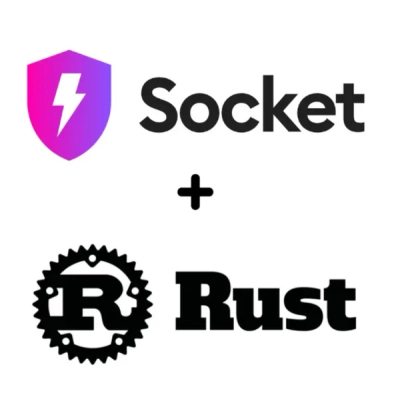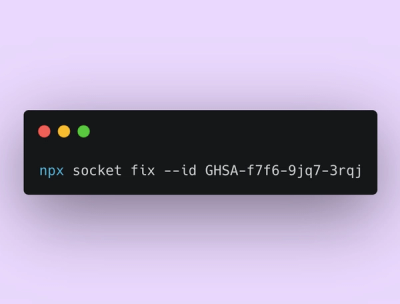
Product
Introducing Custom Pull Request Alert Comment Headers
Socket now lets you customize pull request alert headers, helping security teams share clear guidance right in PRs to speed reviews and reduce back-and-forth.
Dependency Injection Container for JavaScript, with following goals:
npm install di1
Services inside DI container, can be referenced using tokens.
Token for registering service or specifying dependency, can be created using createToken function:
function createToken<ServiceType>(name?: string): Token;
name argument here, is to be used for debug messages in cases like when having error about cyclic dependency.
There is also a special kind of which allows accessing DI container itself from a service.
Such a token can be created using containerToken function:
function containerToken(...deps: Injectable[]): Token
Which as an argument optionally has a list of dependencies which should be available for the container, this affects in which specific container in the hierarchy service using it is to be created.
This is useful for more dynamic cases when requesting dependencies known only at runtime time.
Also, this makes it possible to have cyclic dependencies, in limited cases(which btw, better to be avoided whenever possible).
Typically service should be defined using declareService funtion:
function declareService(depsObject, factory): Declaration;
which creates a service declaration using object specifying dependencies(list of service tokens or other declarations),
and a factory function to be called with object of dependency instances(having same shape as depsObject)
There is also a bit more low level version of this:
function declareServiceRaw(factory, ...deps): Declaration
the only difference is that dependencies would be injected as separate function arguments into factory function. It is slightly closer to how things work internally, but most of the difference is in how it looks.
Supposedly declareService should be more convenient in most of the cases, and suggested as preferred option.
class Container - Dependency injection container. Represents a registry of service declarations, and cache of already created instances.
To register declaration for given token, or to replace/override previously declared service register method can be used:
container.register(tokenOrDeclaration, declaration)
Because it is allowed to have service declaration as a dependency - it might be useful to register it to be created on specific layer in the container hierarchy. (by default it would be created in upper possible layer having all the dependencies)
For this case it is possible to register the declaration in the specific container (effectively limiting it to be created in it or its decedents)
container.register(declaration)
To create a service instance or to use previously created one - get method is to be used:
container.get(tokenOrDeclaration)
There are cases when there is a need for separate context for services to be created,
while allowing to reuse some service instances from existing context, this can be done createChild method:
container.createChild()
import {
declareService,
declareServiceRaw,
Container,
createToken,
containerToken,
} from 'di1';
// declare service without dependencies
const svc1 = declareServiceRaw(() => 1);
// declare service with dependency on other declaration
const svc2 = declareServiceRaw(one => 1 + one, svc1);
// declaring a service specifying dependencies as object
const svc3 = declareService(
// dependencies to be inject
{
one: svc1,
two: svc2
},
({ one, two }) => {
return one + two;
}
);
// by default declaration are unnamed
// but for debug purposes name can be assigned to it
svc3.name = 'svc3';
// or specified as name of factory function
const svc4 = declareServiceRaw(function svc4(){ return 1 });
// create container instance
const rootContainer = new Container();
// get instance of specific service
// if not previously registered - declaration would be automatically registered at root container
rootContainer.get(svc3); // will return 3
// creating token for service to be registered later
// token name is optional, but might be helpful for debug purposes
const token1 = createToken('one');
// get instance of specific service using declaration as token
rootContainer.register(token1, svc1); // will return 3
rootContainer.get(token1); // will return 1 by creating new service instance using declaration svc1
// creating child container
const childContainer = rootContainer.createChild();
childContainer.get(svc3); // will return 3 by reusing service instance created previously in parent container
// overriding existing implementation
childContainer.register(svc2, declareServiceRaw(() => 0));
// now when requesting service with overridden dependency, new instance would be created in child container
// for svc1 dependency instance from parent container would be used
// for svc2 new instance would be created in child container using new declaration
childContainer.get(svc3); // will return 1
rootContainer.get(svc3); // will still use originally created instance (will return 3)
// dealing with circular dependencies
const t1 = createToken('t1');
const t2 = createToken('t2');
const s1 = declareServiceRaw(s2 => {
return { s2 };
}, t2);
const s2 = declareServiceRaw(container => {
return () => {
const s1 = container.get(t1);
};
}, containerToken(t1));
rootContainer.register(t1, s1);
rootContainer.register(t2, s2);
const s1instance = rootContainer.get(t1);
This is cases when there is a need to create a child container providing context specific implementations while reusing not specific whenever possible.
For example, imagine simple shopping app, having following services registered in root container:
products - provides access to products dbuser (depends on: session)cart (depends on: user, products)But session in request specific, and so implementation is to be registered in a child container(created per request),
the following will happen:
products service would be created just once and will be reused across all requestscart and user services will be created for each session separately0.4.3 (2020-07-16)
FAQs
Simple but yet powerful, DI container for JavaScript or TypeScript
The npm package di1 receives a total of 3 weekly downloads. As such, di1 popularity was classified as not popular.
We found that di1 demonstrated a not healthy version release cadence and project activity because the last version was released a year ago. It has 1 open source maintainer collaborating on the project.
Did you know?

Socket for GitHub automatically highlights issues in each pull request and monitors the health of all your open source dependencies. Discover the contents of your packages and block harmful activity before you install or update your dependencies.

Product
Socket now lets you customize pull request alert headers, helping security teams share clear guidance right in PRs to speed reviews and reduce back-and-forth.

Product
Socket's Rust support is moving to Beta: all users can scan Cargo projects and generate SBOMs, including Cargo.toml-only crates, with Rust-aware supply chain checks.

Product
Socket Fix 2.0 brings targeted CVE remediation, smarter upgrade planning, and broader ecosystem support to help developers get to zero alerts.